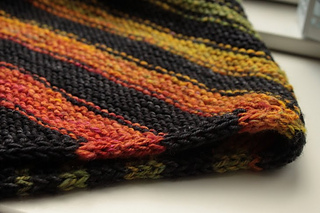patterns >  Knitter's Kitchen Designs
Knitter's Kitchen Designs
> Biased Stripes








Biased Stripes
Only using about 1½ skein of DK weight yarn, this cowl is a great and quick accessory to make! It looks good on both sides, the garter stitch and color changes giving a different effect for the “wrong” side.
Use one solid and one color changing yarn, two semisolids, two color changing, or several different colors of yarn - it’s up to you.
Biased stripes is a cowl in garter stitch with stripes and rounded i-cord edges. It is worked flat and on the bias, increasing and decreasing a stitch on every second row to create the slanting stripes. The two ends are then grafted together using kitchener stitch, so the cowl becomes a seamless looking piece.
If you only use two different yarns, a minimum of weaving in of ends is required. The color yarn that is not active is brought up along the side at the work, cleverly hidden inside the i-cord edging.
Illustrated directions are given for how to handle the color changes and managing the resting yarn while working a stripe.
71264 projects
stashed
54902 times
1303 projects
stashed
1318 times
110 projects
stashed
112 times
168 projects
stashed
185 times
676 projects
stashed
522 times
- First published: January 2014
- Page created: January 22, 2014
- Last updated: February 26, 2014 …
- visits in the last 24 hours
- visitors right now





